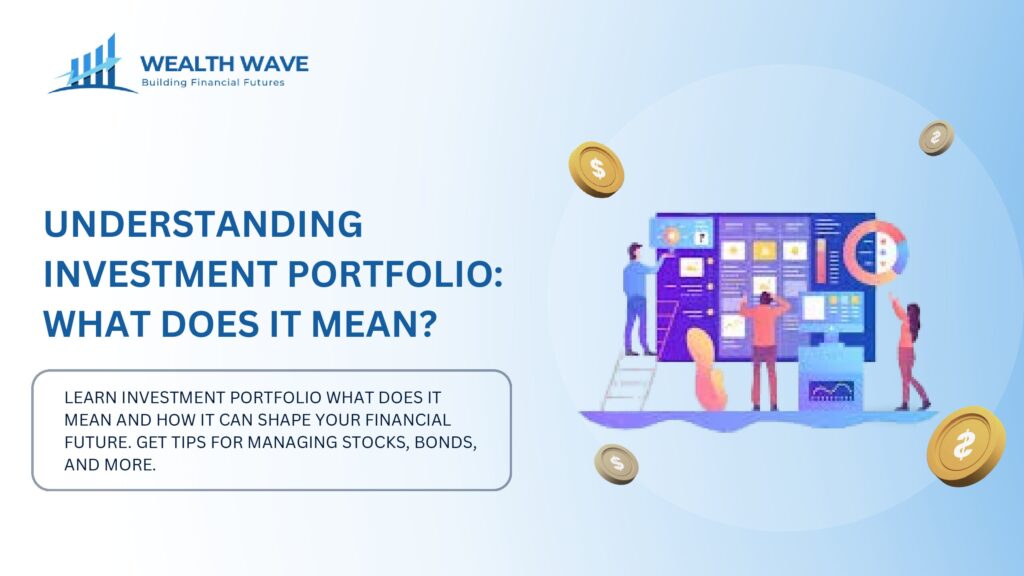Are you trying to understand investment portfolio, what does it means and it can shape your financial future? Many people feel lost when they start thinking about how to manage their money for the future. An “investment portfolio” might sound complex, but it’s just a way to keep track of your assets like stocks, bonds, and real estate.
Knowing about your investment portfolio is key to planning your financial future.
An important fact is that an investment portfolio can include many different things such as cash, cryptocurrencies, and mutual funds. This article will explain how these parts come together to help you reach your goals.
Whether you want to grow your wealth or make sure you have enough for retirement, understanding your investment portfolio is the first step. Keep reading for easy tips on building a strong financial plan.
Key Takeaways
- An investment portfolio holds different assets like stocks, bonds, and real estate. This mix helps reach financial goals.
- Types of portfolios include aggressive for growth, defensive for safety, income-focused for steady cash, speculative for high risk/reward, and hybrid for balance.
- Building a strong investment portfolio requires planning your asset mix based on goals and risk tolerance. It includes diversifying investments to manage risks effectively.
- Regularly reviewing and adjusting your investments ensures they align with your financial plans. Rebalancing keeps the right asset mix over time.
- Planning early for retirement is smart. Using ETFs can simplify investing in various assets to help grow savings.
What is an Investment Portfolio?

An investment portfolio is a collection of financial assets owned by an individual or organization. These assets may include stocks, bonds, cash equivalents, and other investments.
Definition

An investment portfolio is a collection of financial assets owned by an investor. This can include stocks, bonds, currencies, cash and cash equivalents, and commodities. It serves as a way for individuals to manage their wealth.
A well-structured portfolio helps investors reach their financial goals.
A financial portfolio reflects an individual’s investment strategy. Asset allocation plays a key role in this process. It involves diversifying investments across different asset classes to manage risk effectively.
Understanding how these components work together is essential for building an effective investment portfolio.
Components

An investment portfolio has several parts. These include stocks, bonds, and cash. Stocks are shares in companies. Bonds are loans to governments or corporations. Cash can be regular money or equivalents that can quickly turn into cash.
Other components may include mutual funds and exchange-traded funds (ETFs). Mutual funds pool money from many investors to buy a mix of assets. ETFs work like stocks but track an index or commodity.
Also, portfolios can hold real estate or cryptocurrency for added diversity. Each part plays a role in managing risk and generating income for the investor’s goals.
Types of Investment Portfolios

Investment portfolios come in many types. Each type serves a different goal and strategy for investors.
Aggressive

Aggressive portfolios focus on high growth. They often contain stocks and other assets with the potential for big returns. Investors in aggressive portfolios seek to maximize their return on investment (ROI).
This type of portfolio may include more risk, as it is less concerned about short-term market volatility.
Investors should expect wider price swings with an aggressive portfolio. It typically contains a larger share of stocks, including small-cap companies. Bonds and cash are present but make up a smaller part of the whole.
An aggressive strategy aims for long-term wealth management by investing heavily in equities and other growth-oriented assets while managing risks carefully.
Defensive

Defensive portfolios focus on safety. They aim to protect capital during market downturns. This type of investment portfolio often includes stable assets like bonds and dividend-paying stocks.
Investors seek these assets for lower risk and steady income generation.
A defensive portfolio is suitable for those with a low tolerance for risk. These investors prefer stability over high returns. By including cash equivalents, they can preserve capital while still earning some income.
Diversification remains key, as it helps manage risk effectively within the overall financial plan.
Income-focused
An income-focused investment portfolio aims to generate steady cash flow. This type of portfolio often includes stocks, bonds, and other assets that pay dividends or interest. Investors seek capital preservation while earning regular income.
Bonds play a key role in this strategy as they provide reliable interest payments.
Exchange-traded funds (ETFs) can also be part of an income-focused portfolio. They allow investors to gain exposure to dividend-paying stocks or high-yield bonds without buying individual securities.
Assessments of the investment portfolio help ensure it meets the investor’s financial goals and risk management needs. With careful planning and monitoring, an income-focused approach can support long-term financial stability.
Speculative
A speculative investment portfolio focuses on high-risk assets. Investors hope to gain big rewards from these investments. This type of portfolio may include stocks, cryptocurrencies, or trendy startups.
These investments can be volatile and may change in value quickly.
Investors who choose a speculative approach often seek fast profits. They are aware that they could also lose money. Speculative portfolios require good research and careful planning.
Understanding the stock market is key for success in this area of financial planning.
Hybrid
A hybrid investment portfolio combines different asset types. It includes both stocks and bonds, along with other investments like real estate or cryptocurrency. This mix allows the investor to balance risk and returns.
The goal is to create a portfolio that meets individual financial goals while managing risks effectively.
Investors can adjust their asset allocation based on their risk tolerance. A hybrid approach offers flexibility for growth and stability. This type of portfolio is suitable for those who want diversity in their investments.
Next, it’s essential to focus on building and managing an investment portfolio effectively.
Building and Managing an Investment Portfolio

Building an investment portfolio requires careful planning. Investors must choose the right mix of assets to fit their goals and risk tolerance.
Determining asset allocation
Asset allocation is key for an investment portfolio. It involves spreading investments across different asset classes. This can include stocks, bonds, and real estate. Each type of asset behaves differently in the market.
By diversifying, investors can manage risk better.
Investors should consider their financial goals and risk tolerance when deciding how to allocate assets. A well-planned allocation helps align with these goals. For example, younger investors may prefer more aggressive options like stocks or ETFs for growth potential.
In contrast, those closer to retirement might focus on safer choices like bonds to protect their savings.
Diversification
Diversification helps reduce risk in an investment portfolio. It involves spreading investments across different asset classes. This can include stocks, bonds, real estate, and even cryptocurrencies.
By doing this, investors protect themselves from big losses in one area.
A well-diversified portfolio can support financial goals and match an individual’s risk tolerance. Asset allocation is key to diversification. It allows investors to balance their investments smartly across various types of assets.
Understanding investment portfolios also means knowing how to diversify effectively for better security in the long run.
Managing risk
Managing risk is key for any investment portfolio. It helps protect against losses. An investor can manage risk by ensuring a good mix of assets. This means having stocks, bonds, and even real estate in their collection.
A strong balance can lessen the impact if one area performs poorly.
An investment portfolio should align with the investor’s financial goals and risk tolerance. Regular assessments help keep this alignment. Investors need to review their portfolios often to adjust asset allocation as needed.
Staying aware of market changes is vital for success in managing risks within an investment portfolio.
Rebalancing
Rebalancing is a key part of managing an investment portfolio. This process involves adjusting the mix of assets in the portfolio. Investors do this to keep their investments aligned with their financial goals and risk tolerance.
Over time, some assets may grow faster than others. This can change the overall balance of the portfolio. For example, if stocks increase in value, they might make up a larger part of the portfolio than intended.
To correct this, investors sell some stocks and buy other assets like bonds or ETFs. Regular rebalancing helps maintain a good asset allocation and manages risk effectively.
Tips for Investing and Retirement Planning

Investing wisely can help grow savings for the future. It is smart to compare different financial products to find what fits best. Using Exchange-Traded Funds (ETFs) can offer a simple way to invest in various assets.
Alternative investments may also help diversify a portfolio. Planning early for retirement can make it easier later on. For more insights on investment strategies, keep reading!
Comparing financial products
Comparing financial products helps investors make smart choices. An investment portfolio can include various assets, like stocks, bonds, and exchange-traded funds (ETFs). Each type of asset has different risks and returns.
Investors should look at these differences closely.
Understanding how each product works is key. Stocks may offer higher growth but come with more risk. Bonds tend to be safer but usually provide lower returns. By comparing these options, an investor can build a balanced portfolio that fits their goals and risk tolerance.
Proper assessment ensures the investment choices align with the individual’s financial plans.
Using ETFs
ETFs, or exchange-traded funds, are popular investment tools. They allow investors to buy a collection of stocks, bonds, and other assets in one package. This makes investing easy and affordable for many people.
An investment portfolio can include ETFs alongside other investments such as stocks and mutual funds.
Using ETFs helps with diversification. This means spreading money across different types of assets to lower risk. Investors can find various ETFs that track specific markets or sectors.
These options give investors flexibility based on their goals and risk tolerance. By adding ETFs to an investment portfolio, individuals can work toward their financial objectives more effectively.
Considering alternative investments
Alternative investments can be a smart choice for an investment portfolio. These assets include real estate, commodities, and cryptocurrencies. They help diversify the portfolio beyond traditional stocks and bonds.
A varied mix can lower risk during market changes.
Investors may find opportunities in exchange-traded funds (ETFs) or other unique options. Alternative investments often respond differently to market events than standard stocks or bonds.
This difference offers potential for growth when regular markets struggle. An investment portfolio that includes these alternatives can better align with financial goals and risk tolerance.
Planning for retirement.
Investors must plan for retirement to ensure a secure future. An investment portfolio can help meet this goal. It should include various assets like stocks, bonds, and exchange-traded funds (ETFs).
This mix helps in managing risk while aiming for growth.
Building a strong portfolio requires careful research and strategic planning. Investors need to assess their financial goals and risk tolerance. They should review their investment portfolio regularly.
This way, they can adjust it as needed to stay aligned with their plans for retirement.
FAQs
Q1. What does understanding an investment portfolio mean?
Ans. Understanding an investment portfolio means knowing the mix of assets you hold, like Exchange-Traded Funds (ETFs) or bonds, and how they're managed.
Q2. How is a bond portfolio part of an investment portfolio?
Ans. A bond portfolio is a type of asset in your overall investment collection that focuses on bonds for income and stability.
Q3. Why are ETFs important to an investment portfolio?
Ans. ETFs offer variety in your investments since they track different markets or industries. They can help diversify your holdings and manage risk.
Q4. Can anyone manage their own investment portfolio?
Ans. Yes! But it requires knowledge about different assets like ETFs and bonds, as well as skills in managing these investments over time.




